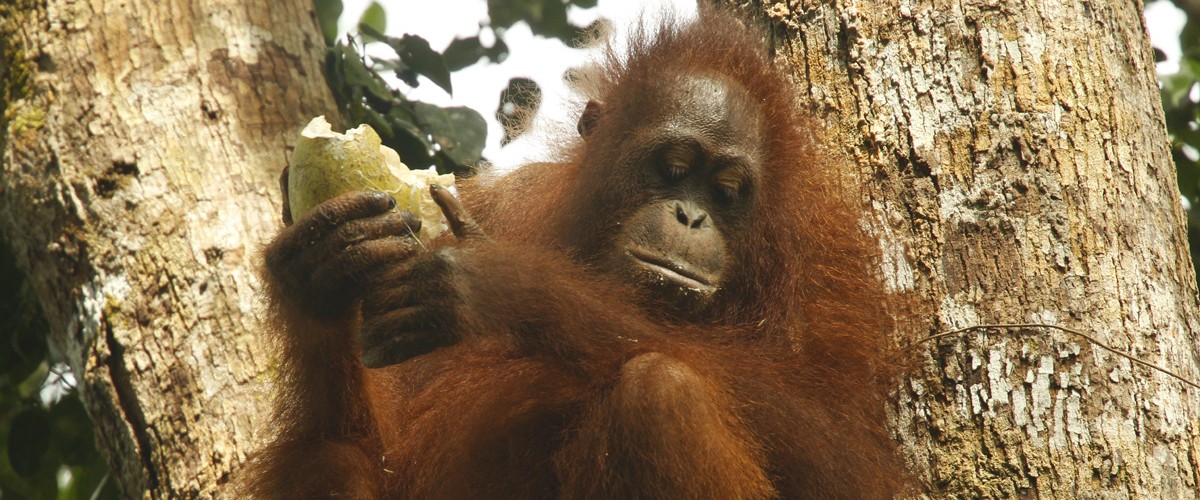By Brodie Philp, GPOCP Research Manager
The forest in Gunung Palung National Park is ever changing. Through our daily searches and follows one becomes very familiar with every area of the forest. During our nightly meetings the status of one single tree in this vast rainforest can be discussed as if it were a person that everyone on the research team has known for years. For an even broader perspective, we can consult our extensive phenological records on tree fruiting patterns to see what is happening with certain species or to examine large-scale habitat variation over time.
One aspect of orangutan behavior that has remained constant for a majority of the last 6 months has been the popularity of the freshwater and peat swamp habitats. These were the places to be! The orangutans seemed to be drawn there and thus our follows focused heavily in these areas as well – until recently that is. Of late the mountainous habitat surrounding Cabang Panti Research Station has started to fruit with multiple species. With plentiful Willughbeia, Baccaurea and Irvingia, some of our resident orangutans have started to head upslope to forage and we’ve also had the pleasure of seeing individuals that haven’t made an appearance for quite a while.
 |
|
Morning light shining through the thick tree canopy at Cabang Panti Research Station in Gunung Palung National Park. Photo credit Brodie Philp.
|
A particular point of interest is the number of unflanged males we have been seeing. Our resident flanged male, Alfred, has not been seen for some time, although we still hear his long calls, deep in the swamp. This seems to have given the unflanged males a new opportunity! These males without cheek pads tend to be very nomadic as they travel in search of food and females. With Alfred absent, we have seen four unflanged males in close proximity to camp. Is this due to fruiting on the mountain? Is it due to Alfred’s absence? Or could there be something else enticing them to hang around more in these areas?
One common factor in nearly all of these follows has been an adult female orangutan, Walimah. Walimah is one of our most studied females; in fact, she has been followed since birth! Back in 2015, she became quite well known when she was featured in the Nat Geo Wild episode “Mission Critical: Orangutans on the Edge”. The program documented Walimah’s serious foot injury and loss of her infant. While this was a devastating event for her, as well as for the research team, it has given us an interesting opportunity to observe her behavior after this rare infant loss. Orangutans are known for their slow life history, having the longest inter-birth interval of any mammal, around 6-8 years. Their infants rarely die – in fact this was our first known infant death at Cabang Panti (see Code Red from April 2016 to learn what happened to her). Normally, females willingly start mating again when their current offspring is nearing independence. But with Walimah losing her baby so suddenly, we have been waiting to see how long it would take her to physically recover and conceive again.
Our research methods allow us to see changes in Walimah’s health through analyzing chemicals and hormones in her urine. We can also observe her behavior and social interactions with other orangutans. When I first followed Walimah back in April she was annoying a mother orangutan. The mother kept kiss squeaking at Walimah as she moved closer to her baby, apparently wanting to interact with it. We can only imagine the thoughts going through the mind of this intelligent animal as she approached another orangutan’s baby, after losing her own.
 |
|
Research field assistant, Toto, collecting a urine sample. Photo copyright Tim Laman.
|
Recently, however, it has been Walimah’s interactions with males that have been the most intriguing. She started mating again soon after she lost her infant, but we’ve been eagerly waiting for her to conceive again. Last month we saw Walimah being followed by two separate males for several days each. One was Mr. Kecil (or Mr. Small in English) who spent a lot of time close to her. The anticipation was high amongst the field assistants each time they edged closer. When Walimah would sit on a branch he would slowly climb down and sit next to her for a few seconds before he climbed off again. During this period, despite their close association, nothing happened. Even sitting next to each other sharing a termite-filled log wasn’t enough to ignite a spark!
 |
|
Bosman checking on the whereabouts of Walimah. Photo credit Brodie Philp.
|
A few weeks later, we found Walimah with another male, Bosman. It wasn’t long before Bosman’s intentions were clear and our assistants observed them mating. Hassan, our longest serving field assistant, happily walked into camp with a video recording of the event. The next day, I was with Hassan in the forest and it happened again. The mating seemed pretty mutual between the two of them, although I must say Walimah didn’t look too interested during the event. She was seen reaching out and pulling leaves off a branch and swinging around a small twig, in what could only be described as boredom, as Bosman went about his business. The two continued to travel and feed together for several more days before mating for a third time. These events were recorded so we can analyze their mating behavior and body language down to the smallest detail, even documenting the number of thrusts involved. Will these recent interactions with Bosman lead to a pregnancy? Sounds more like a sentence from a TV drama than wildlife research – but let’s hope so!
From here on out we will carry pregnancy tests in our field gear to test Walimah’s urine during our upcoming follows. Regardless of the results, it is an interesting time to continue following Walimah and expand our intricate knowledge of this orangutan’s life.
 |
|
Walimah, the most studied orangutan at Cabang Panti. Photo copyright Tim Laman.
|









